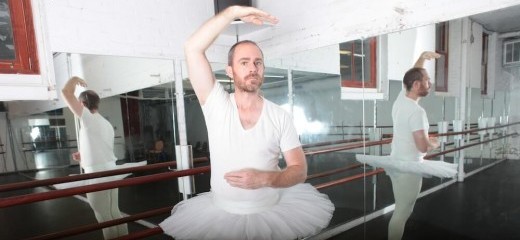
All I Want For Christmas is One-Man Nutcracker
by Mira Treatman
Theatre Philadelphia and thINKingDANCE continue our partnership, begun in 2018, bringing coverage and new perspectives to Philadelphia’s vibrant theatre scene.
The rumblings of an orchestra tuning rustle up the full lobby of patrons entering the third floor of Plays & Players. But there’s no orchestra; this Nutcracker is made for a black box theatre with a recording of the Tchaikovsky score. There are no ballet dancers on the premises either.
We’re entering the magical space co-created by director Mary Tuomanen, choreographer Hallie Rumsey-Lasersohn, and sound designer Adriano Shaplin, all in the service of our man of the hour, Chris Davis. Enter One-Man Nutcracker.
The concept is clean and delightful. The playwright and performer, known for his one-man plays, which often take place in bars from South Philly to Edinburgh, condenses the two-hour classic into a ballet “power hour” of sorts. Finding ingenuity and creativity in restriction, this solo nut epitomizes American theatrical scrappy solvency and combines it with the enduring power of the cross-generational nostalgia-infused togetherness that is Christmas. The reason for the season is cracking nuts.
Davis’ strategy for structuring the piece indicates his stagecraft experience. In his monologues, he openly professes to having little dance experience. Repeatedly he bemoans that he hasn’t stretched in over a decade. Davis’ direct relationship to ballet is through his girlfriend, Rumsey-Lasersohn, a dancer with American Repertory Ballet. After being inspired by her dedication to the grueling runs of The Nutcracker over many years, Davis started taking ballet classes at BalletX in preparation for the show. His care for this newly adopted craft shined throughout the solo.
Without laying claim to being a dancer, Davis still moves with great confidence and, at times, gusto and grace, which in my mind renders him a dancer. At the heart of this single performer reverie is his seamless jumping from character to character.
Davis nails several of the iconic pantomimes, defying the roles’ defined gender and age. He convincingly expresses Marie’s excitement on Christmas Eve at the top of Act I when she peers through the door to watch her parents trim the tree. His wide eyes and tenderness while wearing a white lacy nightgown convincingly capture that little-girl energy.
In Act II, Davis transforms into the Nutcracker Prince, performing an extended pantomime in which he details the heroic actions he accomplished in Act I. Many in the audience would also recognize this choreography from the 1993 film adaptation of the Balanchine production with Macaulay Culkin as the prince. Davis remarks on this connection throughout the show, and leans into the love-to-hate/hate-to-love status that iconic screen adaption holds for those who grew up with the film.
Present throughout the show is the "father of American ballet," George Balanchine, who produced the first commercially successful Nutcracker on New York City Ballet in 1954. Much of the choreography staged by Rumsey-Lasersohn is verbatim from the Balanchine production, which in turn was after the original 1892 choreography by Marius Petipa with Lev Ivanov. Jerome Robbins also contributed choreography to Balanchine’s battle scene, which Davis includes as well as he scurries around as a frightening mouse.
New York City Ballet’s production has a profound effect on Davis' show quite directly, by dictating the tempo for the Tchaikovsky score. Davis disclosed that he (presumably in collaboration with Shaplin) ripped the audio used throughout the show directly from a live recording of City Ballet’s Nutcracker in 2011. This choice means that the tempo is sped way up to accommodate that company’s quick style. This up-tempo frenzy, notably during the Chinese Tea and Russian Candy Cane variations, was a vehicle to showcase Davis’ clowning and the physical elasticity required to pull it off.
What would Christmas be without The Nutcracker? What would The Nutcracker be without Tchaikovsky? Tonally, Davis’ most sophisticated scene from the play is his Waltz of the Snowflakes at the end of Act I. He goes into a monologue detailing Tchaikovsky’s writing process, and why, perhaps, the music is so beloved.
Davis shares that at the time of the music’s genesis, Tchaikovsky was mourning the death of his sister Alexandra. It is believed that perhaps Marie as the young, happy little girl who gets transported to a magical land of sweets, eternally living on Christmas Eve, is a memorial to her. This sweet sibling elegy comes out somberly in sections like the Snow scene, but most vividly during the grand pas de deux between the Sugarplum Fairy and her Cavalier. Those first bars on the harp arpeggiate like a quivering heartbeat; Davis rose to the occasion of acting against the music’s gravity. Davis’ monologue on Tchaikovsky’s writing has the most depth, as if he relates to this hidden history in the world’s most ubiquitous ballet score, more than any other element of the classic.
Chris Davis’ One-Man Nutcracker expertly delivered on its promise, and brought forth more than just the inherent physical comedy of an everyday comedian performing a ballet in its entirety. The tenderness of Americanized Christmas, family, and loss was not lost on the creator-performer. I found this show incredibly cathartic; a refuge from the ensuing period of complicated family gatherings, short days, and long, cold nights. I hope this One-Man Nut comes back every year too.
One-Man Nutcracker, Chris Davis, Plays & Players Theatre, December 18-24.
To join the conversation, follow thINKingDANCE and Theatre Philadelphia online and on social media to read, share, and comment.
By Mira Treatman
January 6, 2020









